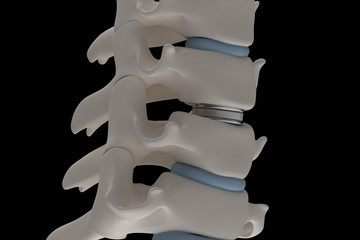Cervical Disc Replacement: What to Expect
What is Cervical Disc Replacement?
Cervical arthroplasty, also known as cervical disc arthroplasty or cervical ADR is a cutting-edge surgical procedure that has revolutionized the management of neck pain and disc disease.
Unlike traditional treatments like anterior cervical discectomy and fusion (ACDF), cervical arthroplasty preserves neck movement and minimizes the risk of adjacent segment degeneration.
In this comprehensive guide, we will explore cervical arthroplasty, its benefits over other surgical options, and how it can provide lasting relief for those suffering from damaged discs, disc herniation, and more.
Understanding Cervical Arthroplasty
Cervical arthroplasty is a surgical technique designed to treat cervical spine conditions that result from damaged discs, such as disc herniation and disc disease. Unlike ACDF, which involves fusing the affected vertebrae together, cervical arthroplasty focuses on maintaining the natural movement of the cervical spine. This innovative approach involves the insertion of an artificial disc into the disc space, preserving neck motion and reducing the risk of adjacent segment degeneration.
The Problem of Neck Pain and Disc Disease
Neck pain is a common complaint, often stemming from issues within the cervical spine. One prevalent cause is disc disease, characterized by the deterioration of the discs that cushion the vertebrae.
Over time, this can lead to disc herniation, where the inner gel-like material of the disc protrudes and can impinge on nearby nerve or spinal cord structures. The result? Pain, tingling, numbness, and sometimes weakness, typically radiating into the arms.
The Traditional Approach: Anterior Cervical Discectomy and Fusion (ACDF)
Historically, ACDF has been the gold standard for addressing cervical disc problems. This procedure involves the removal of the damaged disc and the fusion of adjacent vertebrae using bone grafts or implants. While ACDF can be highly effective in relieving pain and stabilizing the spine, it does come with some limitations.
One key drawback of ACDF is that it can restrict the natural movement of the cervical spine, which can lead to increased stress on other discs. Over time, this may result in adjacent segment degeneration, which may lead to the need for further spine surgery. Additionally, ACDF can limit neck movement, affecting a patient’s ability to perform certain activities.
The Modern Solution: Cervical Arthroplasty
Cervical arthroplasty offers an alternative approach to treating cervical spine conditions. Instead of fusing the vertebrae, this surgical procedure is a disc replacement surgery. This involves the insertion of an artificial disc into the damaged disc space. This artificial disc mimics the function of a healthy disc, preserving the natural motion of the neck.
Benefits of Cervical Disc Replacement
Preservation of Neck Movement
Cervical arthroplasty allows for continued neck movement, which is especially important in maintaining flexibility and range of motion after surgery.
Reduced Risk of Adjacent Segment Degeneration:
By maintaining the natural motion of the cervical spine, cervical disc replacement helps reduce the risk of adjacent segment degeneration, a common issue with fusion surgeries.
Effective Pain Relief:
Patients who undergo cervical arthroplasty often experience significant relief from arm pain and other symptoms associated with damaged discs.
Quicker Recovery:
Recovery time after cervical arthroplasty is generally shorter compared to ACDF, allowing patients to return to their regular activities sooner.
Lower Risk of Blood Clots:
Unlike spinal fusion surgeries, cervical arthroplasty is associated with a lower risk of blood clots.
No Risk of Bone Spurs: Fusion surgeries may lead to the development of bone spurs at the fusion site, which is not a concern with cervical arthroplasty.
Risks of Cervical Arthroplasty
While cervical arthroplasty offers numerous benefits in the treatment of neck pain and disc disease, it is important to be aware of the potential risks associated with this surgical procedure.
As with any surgery, there are inherent risks involved including:
Infection
Bleeding
Adverse reactions to anesthesia
Additionally, cervical arthroplasty may carry specific risks such as implant-related complications, such as device migration or wear and tear over time.
While cervical arthroplasty reduces the risk of adjacent segment degeneration compared to fusion procedures, it is not entirely without this risk. Patients should also be aware of the possibility of neurological complications, such as injury to the spinal cord or nerve roots during the surgery.
Such occurrences are relatively rare and typically minimized with experienced surgical teams. Patients should discuss potential risks and complications with their surgeon and make decisions based on their own health and needs.
How is the procedure performed?
Cervical arthroplasty involves several key steps.
Patient Evaluation: A thorough evaluation is conducted to determine if the patient is a suitable candidate for cervical arthroplasty.
Anesthesia: The procedure is performed under general anesthesia to ensure the patient’s comfort.
Accessing the Spine: A small incision is made in the front of the neck to access the cervical spine.
Disc Removal: The damaged disc is carefully removed to alleviate pressure on the nerve or spinal cord.
Artificial Disc Insertion: The artificial disc is inserted into the vacant disc space to restore normal function.
Closure: The incision is closed, and the surgical site is carefully monitored.
Patient Selection for Cervical Arthroplasty
It’s important to note that not all patients are suitable candidates for cervical arthroplasty. A thorough evaluation by a spine specialist is essential to determine if this procedure is the right choice. Factors such as the patient’s age, overall health, and the extent of cervical spine damage are considered during the assessment.
Patients with certain medical conditions, like severe osteoporosis or advanced degenerative disc disease, may not be ideal candidates for cervical arthroplasty. In these cases, doctors may recommend alternative surgical approaches or conservative treatments
It's time to get back to doing what you love.
There is no need to suffer in pain!
Cervical arthroplasty, or cervical artificial disc replacement, represents a significant advancement in spine surgery. It offers an effective solution for neck pain and disc disease while preserving neck movement and reducing the risk of complications compared to traditional fusion surgeries like ACDF.
With the potential for quicker recovery, improved range of motion, and reduced risk of complications, cervical arthroplasty may be the key to regaining your quality of life.
Don’t let neck pain hold you back; consider the possibilities that cervical arthroplasty can offer on your journey to a pain-free and active future.
If you’re experiencing neck pain or have been diagnosed with a cervical spine condition, contact our office today to schedule a consultation with one of our expert Neurosurgeons. We can help you spine explore your treatment options and determine if cervical arthroplasty is the right choice for you.

About Dr. Michael G. Kaiser
Dr. Michael G. Kaiser is a nationally recognized neurosurgeon in North Jersey and is a proud member of Neurosurgeons of New Jersey, practicing out of their Ridgewood office conveniently located on East Ridgewood Avenue. Dr. Kaiser specializes in complex and minimally invasive spine surgeries.






